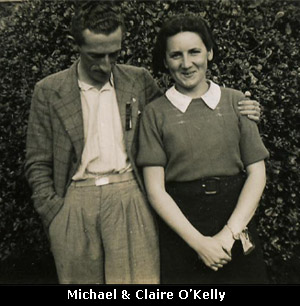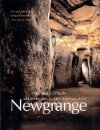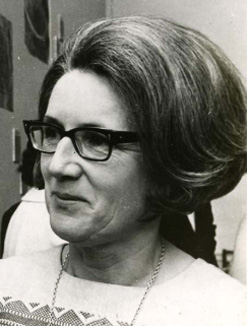Claire O'Kelly (1916-2004)
 Claire
O'Kelly was the wife and archaeology associate of
Michael J. O'Kelly. Claire was born in Cork in 1916 and lived on the
banks of the Lee for most of her life. She qualified as a national school
teacher and while working as a teacher decided to study archaeology at night in
University College Cork under the late Seán P. Ó Ríordáin.
Claire
O'Kelly was the wife and archaeology associate of
Michael J. O'Kelly. Claire was born in Cork in 1916 and lived on the
banks of the Lee for most of her life. She qualified as a national school
teacher and while working as a teacher decided to study archaeology at night in
University College Cork under the late Seán P. Ó Ríordáin.
Her working career in archaeology began alongside her future husband at Seán P. Ó Ríordáin's Lough Gur excavation. These were remarkable times, when the foundation of modern Irish archaeology were laid with the uncovering of settlements dating to the Neolithic and the hitherto unknown beaker period.
She married in 1945, and was forced by the dictate of the time to retire from her teaching post. She now devoted her time to rearing her three children, but as soon as possible was helping out, particularly during the regular summer season excavation. Her role spanned the practical, managerial and domestic all in one day. Often she could be cataloguing finds in the morning, filing accounts in the afternoon and feeding the volunteers by the days end.
Amongst her greatest interests was the Irish language which found practical application when she created many of the archaeological terms for the English/Irish dictionary edited by Tomás De Bhaldraithe. Her interest in Irish language and literature led her to research the references to Brú na Bóinne in early Irish literature, going back to the original sources and reaffirming its identification as Newgrange.
During the Newgrange campaign Claire developed other research interests, publishing papers on the Roman finds at the site and the megalithic art of the Boyne Valley. She painstakingly traced all the carved stones at Newgrange, thereby creating the first complete corpus of the decorated stones.
She also published together with Michael J., a detailed survey of Dowth, the result of countless hours below ground in the cold and damp, working by candle light and lantern. Her own publication, Illustrated Guide to Newgrange, was the first of its kind in Ireland, aimed as it was at the intelligent layperson.
As if this were not enough, she undertook to feed and house the army of archaeologists, distinguished visitors and international students who arrived every season to work on the excavation at Newgrange, as well as looking after her own three children.
In the years following her husband's death, she embarked on the task of preparing for publication his unfinished manuscript Early Ireland, An Introduction to Irish Prehistory, while also ensuring that his papers and excavation archives were put in order and deposited in the relevant institutions. In recognition of her work she was elected a Fellow of the Society of Antiquities of London in 1984.
The O'Kellys met for the first time as students at UCC in 1939 in the Department of Archaeology, "I was only there for the craic", Claire later admitted, "I already had a teaching qualification, but Brian was a serious student. In fact, the star of the show". As students both Michael J. and Claire worked on Seán P. Ó Ríordáin's excavation at the Neolithic site of Lough Gur in County Limerick. It wasn't long before a working relationship turned to something more serious.
With their students years behind them and a position for Michael J. as curator of Cork Public Museum, they married in 1945. The times dictated that they should honeymoon in Ireland and it was in Dingle that a long and fruitful partnership in archaeology and prehistory began. Together they spent their honeymoon checking the accuracy of R.A.S. Macalister's records of ogham inscriptions which had just been published in Corpus Inscriptionum Insularum Celticarum.
Every summer thereafter was spent excavating at sites, ranging from megaliths to ringforts, from west Kerry to north Tipperary. Much of this work was ground-breaking with scientific application and experimental archaeology being introduced for the first time. Together this unique partnership would change the face of Irish archaeology.
Shortly after securing his first-class M.A. at UCC, Michael J. was appointed curator of the recently founded Cork Public Museum in Fitzgerald Park. Both of the O'Kellys were involved in building up the displays and dioramas at the museum. The displays were ground breaking with full sized figures, Michael J. supplying the artefacts and Claire making the clothes in faithful reproductions of the originals. Michael J. remained curator of the museum for over two decades.
Newgrange
 Excavations
at Newgrange commenced in
1962 and continued every summer for a four month season up to and including
1975. The aim of the excavation was to discover as much as possible about the
archaeological and historical context of Newgrange and the people who built it
and to discover what its original finished appearance was so as to direct a
reconstruction, conservation and restoration of the structure to its former
condition and appearance.
Excavations
at Newgrange commenced in
1962 and continued every summer for a four month season up to and including
1975. The aim of the excavation was to discover as much as possible about the
archaeological and historical context of Newgrange and the people who built it
and to discover what its original finished appearance was so as to direct a
reconstruction, conservation and restoration of the structure to its former
condition and appearance.
As part of the early preparation work on Newgrange, Michael J. and Claire O'Kelly travelled to Brittany and Iberia to study at first hand the European background of Newgrange, consulting with the leading experts in those countries on the various features found at Newgrange.
The O'Kellys also consulted widely in Ireland and brought in experts in different fields to advise on the restoration of the great cairn of stones which covers the tomb.
The last year of excavation was 1975, Michael J. wrote "We determined in 1975 that that should be our last season of excavation at Newgrange. We had investigated approximately one third of the structure and we had discovered much about it that was new, both in its structure and in its ornament, while radiocarbon had pushed its date back by 1,000 years. We felt that the other two thirds should be left for a future excavator, who, working with new knowledge and perhaps with better methods and new scientific approaches, should have large areas untouched by us in which to test, check and re-evaluate our findings." From The Restoration of Newgrange by Michael J. O'Kellly. Antiquity LIII, 1979.

In Newgrange Archaeology, Art and Legend Professor O'Kelly presents the full results of his excavations at Newgrange between 1962 and 1975. Every stage in the excavation, interpretation and restoration of the site is described and illustrated with additional contributions from Claire O'Kelly, who collaborated in her husband's work at Newgrange. This book is a must for anyone with a serious interest in Newgrange, while written for the general reader, it is academic in its approach.
Claire O'Kelly obituary - Irish Times November 6th 2004
Scholarly archaeologist with a passion to communicateMany women born in the first half of the 20th century had the talent, vision and drive to be scholars but, because of the social norms of the time, were unable to avail of the professional opportunities and recognition afforded by a university post.
Claire O'Kelly, who has died in Dublin aged 88, was one such. Her achievements illustrate that it is impossible to suppress the scholarly urge and the passion to communicate.
Born in Cork, the third child and only daughter of Edward and Johanna O'Donovan, Claire remained a staunch Corkonian all her life. She qualified as a national school teacher and in the late 1930s achieved her ambition of going to university.
She studied archaeology in University College Cork under Seán P. Ó Ríordáin and there met her future husband, Michael J. (Brian) O'Kelly, later to succeed Seán P. Ó Ríordáin in the chair of archaeology in UCC.
One of the first of their many joint enterprises was the setting up of the Cork Public Museum in 1945. She described vividly the night prior to the official opening when, following long days single-handedly finalising the exhibits and too tired to cycle the 10 miles home to Monkstown, they camped on army-style camp beds in the museum and had cornflakes with water for breakfast. That didn't matter to her, but his comment: "Of course you know there are rats here?" was a bit too much.
In the manner of many a scholar's wife before her, she acted as his right hand and supported all his enterprises. However, Claire O'Kelly's prodigious reading and appetite for knowledge meant that right from the beginning, she carried out her own scholarly projects. A fluent Irish speaker with a great love for the language and culture, her contributions to the English/Irish Dictionary edited by Tomás De Bhaldraithe, for which she created many of the archaeological terms, are a case in point.
When Brian was asked in 1962 to excavate the great Boyne monument of Newgrange, she undertook as a matter of course the feeding and housing of an army of international students and fellow archaeologists each summer, in addition to raising three children. Her own intellectual curiosity though led her to independent research on two important aspects of the monument: the Megalithic art and the literary and antiquarian references to the site.
Before the benefits of present-day technology, her pioneering corpus of the decorated stones at Newgrange was undertaken, painstakingly and in all weathers, by tracing the motifs at actual size from the enormous orthostats, recording a level of detail that no photograph could achieve.
Her interest in Irish language and literature led her to research the references to Brú na Bóinne in early Irish literature and to reaffirm its identification as Newgrange. It was her research into these older traditions that led her to encourage her husband to investigate the persistent references to Newgrange and the sun, with the subsequent discovery in 1967 of the phenomenon of the midwinter solstice, all documented in their book, Newgrange: Archaeology, Art and Legend (1982).
She wryly commented on the inconvenience of being left without the family car with all the Christmas preparations to do, as Brian made his annual pilgrimages 200 miles north to observe the Newgrange solstice.
Other important published areas of research included a detailed and as yet unsurpassed study of Dowth, the third of the three great Boyne monuments, which was the fruit of many cold and damp hours inside the tomb, working only by candles and lanterns.
She was also a communicator. Long before anyone thought that Newgrange and the Boyne Valley monuments would become some of Ireland's leading tourist attractions, she saw the need for reading material for the intelligent layperson. Her guide books to Newgrange and to Lough Gur, Co Limerick, were among the first to be written for Irish archaeological sites.
When Brian died in 1982, leaving behind the manuscript of the book that was to become the standard text, Early Ireland, An Introduction to Irish Prehistory, she set out on the major task of preparing it for the press. It appeared in 1989.
 Claire
O'Kelly's work was recognised by the academic community when she was elected a Fellow of the Society of Antiquaries of London in 1984.
Claire
O'Kelly's work was recognised by the academic community when she was elected a Fellow of the Society of Antiquaries of London in 1984.
Beyond prehistory, interests which she maintained up to her death took in everything from languages and international history to poetry, current affairs and the arts.
Casts of Claire's hands and feet, for instance, were used in many of the sculptures of her late friend, the distinguished artist Gabriel Hayes (wife of Seán P. Ó Ríordáin), most notably the stations of the cross in Galway cathedral.
As a person, she was characterised by her sense of humour, her vigorous opinions, her courage, her persistence, her warmth and her passion for standards.
She is survived by her daughters Helen, Ann and Eve. Claire O'Kelly: born July 21st, 1916; died October 23rd, 2004.
Boyne Valley Private Day Tour
 Immerse yourself in the rich heritage and culture of the Boyne Valley with our full-day private tours.
Visit Newgrange World Heritage site, explore the Hill of Slane, where Saint Patrick famously lit the Paschal fire.
Discover the Hill of Tara, the ancient seat of power for the High Kings of Ireland.
Book Now
Immerse yourself in the rich heritage and culture of the Boyne Valley with our full-day private tours.
Visit Newgrange World Heritage site, explore the Hill of Slane, where Saint Patrick famously lit the Paschal fire.
Discover the Hill of Tara, the ancient seat of power for the High Kings of Ireland.
Book Now
Home
| Visitor Centre
| Tours
| Winter Solstice
| Solstice Lottery
| Images
| Local Area
| News
| Knowth
| Dowth
| Articles
| Art
| Books
| Directions
| Accommodation
| Contact
